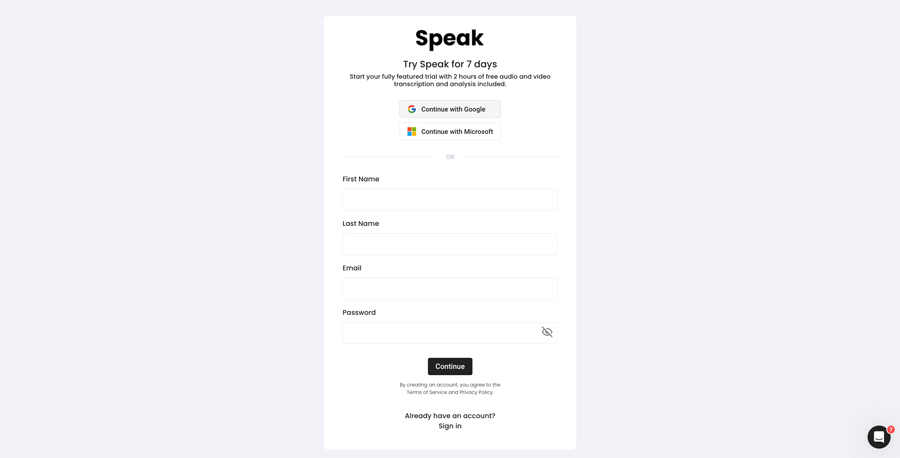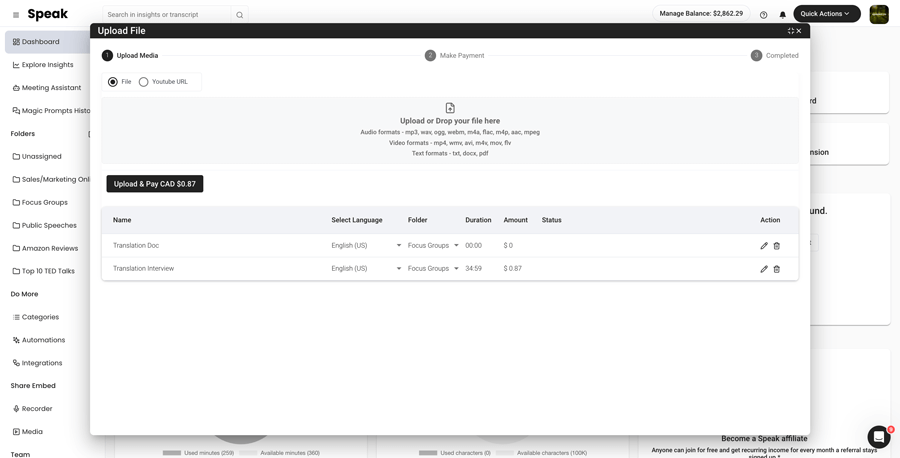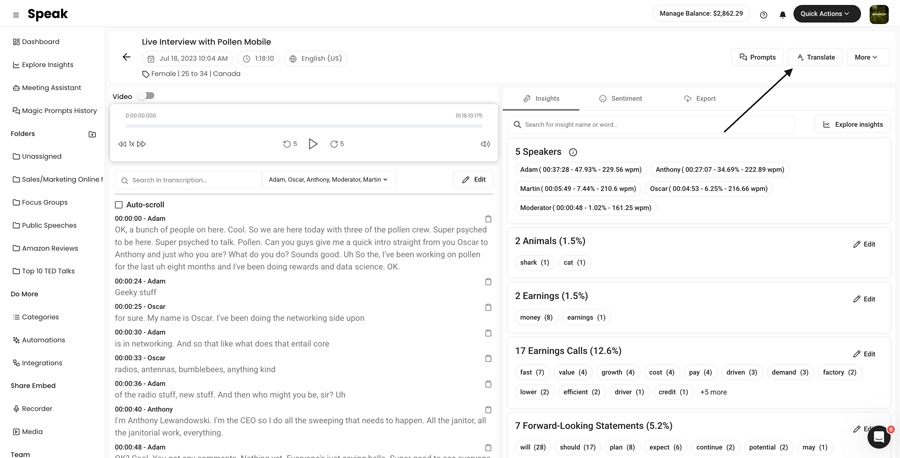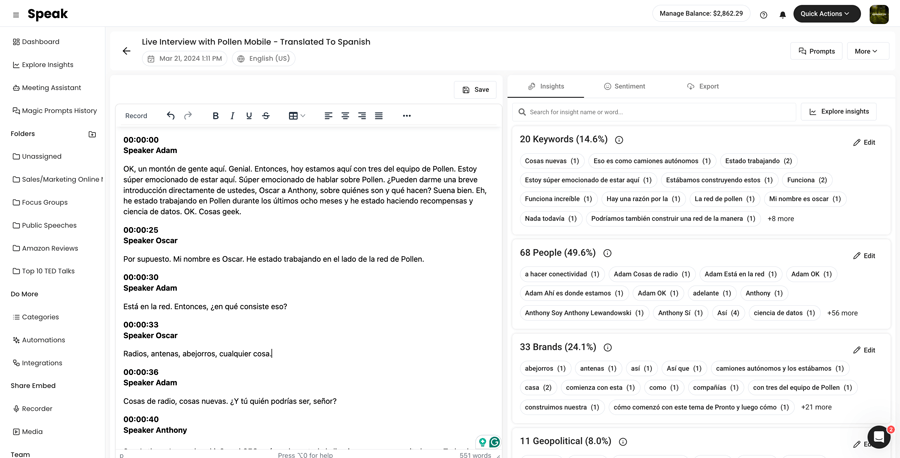How To Translate English (United States) to Chinese (Simplified)
Translating English (United States) to Chinese (Simplified) is super simple!

Step 1: Register for Speak
Register for Speak using this link.
Once you register, you can instantly begin translating your English (United States) to Chinese (Simplified) file(s).

Step 2: Upload Your English (United States) file(s)
As soon as you log in, you will be redirected to the dashboard.
Once there, you can select the Quick Action "New Upload".
In Speak, you can seamlessly upload, transcribe and translate audio, video and text files all at once!

Step 3: Translate Your English (United States) file(s) to Chinese (Simplified)
Once the file is uploaded, simply visit your file and select "Translate".
If it is an audio and video file, Speak will ask you if you want to keep the speaker names and timestamps in the translation.
Want to translate many files at once? No problem!
You can view the files you want to automatically translate from English (United States) to Chinese (Simplified) from the folder level and instantly translate as many files as you need with our artificial intelligence translation in just a few clicks.

Step 4: That's It! View, Analyze, Modify & Export Your New Chinese (Simplified) file(s)
Once the translation is done, you will be alerted and you will see a new document in the same folder your original file is in.
The file will be named the same but with a dash indicating that it is the translated version.
Need support with your English (United States) translation?
We are always here and happy to help at Speak!
Just send us a message on live chat on the bottom right corner and we will ensure you are set up for success.
Interested in translating English (United States) or other languages to different languages? View our entire list of supported translation languages here.
Automatic, accurate, instant AI translation from English (United States) to Chinese (Simplified) is here for you.
Register for Speak using this link and begin translating English (United States) to Chinese (Simplified) today.
An In-Depth Look at English to Chinese (Simplified) Translation: Maximizing Value for Businesses and Researchers
As globalization connects markets and cultures more closely than ever before, the demand for seamless communication across languages has surged. In this digital age, the ability to translate English (United States) to Chinese (Simplified) efficiently is not just a convenience—it's a strategic advantage. Speak Ai, leveraging cutting-edge Natural Language Processing (NLP), large language models, and AI technologies, offers an unparalleled solution for automatic translation, transcending barriers and unlocking potential for researchers and businesses alike.
Understanding the Landscape: The Popularity of English (United States) and Chinese (Simplified)
Before delving into the mechanics and benefits of translation, it’s vital to appreciate the significance of these languages. English, predominant in the United States, serves as a global lingua franca, pivotal in international business, science, and culture. Chinese (Simplified), on the other hand, dominates in China, Singapore, and intersects with the diaspora worldwide, representing a massive economic and cultural sphere. Speaking AI taps into this vast potential, acknowledging the power wielded by these languages in shaping global discourse.
The Power of AI in Translation: From Audio, Video, and Text
The evolution of translation technologies, spearheaded by AI and NLP, has revolutionized how we approach language conversion. Speak Ai’s AI Meeting Assistant exemplifies this progress. By joining platforms like Microsoft Teams, Zoom, Google Meet, and Webex, it not only transcribes but also automatically translates meetings, providing real-time insights and breaking down linguistic barriers. This seamless integration of AI translation into daily operations drastically improves communication, collaboration, and comprehension across diverse teams and client bases.
Bridging Cultures: The Significance of English (United States) to Chinese (Simplified) Translation
Translating from English to Chinese (Simplified) is not merely about converting words; it's about bridging cultures, conveying nuances, and fostering understanding. Speak Ai's sophisticated algorithms ensure that the context, tone, and idiosyncrasies of each language are preserved, enabling authentic and meaningful exchanges.
Benefits and Use Cases: Empowering Businesses and Researchers
- Market Expansion: Companies looking to penetrate Chinese-speaking markets can leverage accurate translations to tailor their messaging and product descriptions, ensuring they resonate with local consumers.
- Academic Collaboration: Researchers collaborating across borders can instantly share findings, interpret studies, and pool resources efficiently, accelerating the pace of innovation and discovery.
- Cost and Time Efficiency: Automatic translation mitigates the need for human translators, reducing expenses and turnaround times significantly, a boon for time-sensitive and budget-conscious operations.
Understanding the Nuances: English (United States) and Chinese (Simplified) Compared
While offering numerous advantages, the task of translating between English and Chinese (Simplified) presents unique challenges due to their structural, grammatical, and cultural differences. Speak Ai’s technology adeptly navigates these complexities, ensuring translations are not just accurate but also contextually relevant and culturally sensitive.
The Transformative Impact of Speak AI’s Translation Technologies
With over 150K users and a stellar 4.9 rating on G2, Speak Ai stands at the forefront of the translation revolution. Our suite of tools embodies the pinnacle of language technology, offering a versatile solution that adapts to the diverse needs of modern enterprises and academic researchers. Whether it's through real-time meeting translations or comprehensive document conversions, Speak Ai is redefining what's possible in cross-lingual communication.
Driving Global Engagement and Innovation
In conclusion, the application of AI in translating English (United States) to Chinese (Simplified) offers unmatched opportunities for businesses and researchers to thrive in a connected world. By eliminating language barriers, fostering mutual understanding, and enhancing communication, Speak Ai sets the stage for global engagement, collaboration, and innovation. Embrace the future of translation with Speak Ai, where language transcends borders.
FAQs
Locations Where English (United States) and Chinese (Simplified) are Popular
English (United States) and Chinese (Simplified) dominate in their respective spheres. English is widely spoken across the United States, Canada, the United Kingdom, Australia, New Zealand, and parts of Africa and Asia. Chinese (Simplified), meanwhile, is primarily used in Mainland China, Singapore, Malaysia, and among Chinese communities globally.
Interesting Stats on Populations and History
With over 1 billion speakers, Chinese is the most spoken language globally, while English, with approximately 1.5 billion learners and speakers, is the most widespread second language. The simplified Chinese script was introduced in the 1950s to promote literacy and has since facilitated communication for millions.
Fun Facts
English alphabets originated from Latin, while Chinese characters, one of the world's oldest writing systems, evolved from pictographs. An interesting linguistic fact is that the English language borrows numerous words from Chinese, such as "tea" (茶, chá) and "ketchup" (茄汁, qiézhī).
Differences and Similarities
English (United States) and Chinese (Simplified) differ significantly in grammar, syntax, and phonology. English follows a Subject-Verb-Object structure, whereas Chinese syntax is more flexible. Phonetically, English has more vowel sounds, while Chinese is tonal. Despite these differences, both languages share a universal role in international business, technology, and culture.
Translate English (United States) To These Other Supported Languages:
- Translate English (United States)-to-Albanian
- Translate English (United States)-to-Amharic
- Translate English (United States)-to-Arabic (Egypt)
- Translate English (United States)-to-Arabic (Iraq)
- Translate English (United States)-to-Arabic (Israel)
- Translate English (United States)-to-Arabic (Jordan)
- Translate English (United States)-to-Arabic (Kuwait)
- Translate English (United States)-to-Arabic (Lebanon)
- Translate English (United States)-to-Arabic (Oman)
- Translate English (United States)-to-Arabic (Palestinian Authority)
- Translate English (United States)-to-Arabic (Qatar)
- Translate English (United States)-to-Arabic (Saudi Arabia)
- Translate English (United States)-to-Arabic (Syrian Arab Republic)
- Translate English (United States)-to-Arabic (United Arab Emirates)
- Translate English (United States)-to-Arabic Modern Standard (Bahrain)
- Translate English (United States)-to-Armenian
- Translate English (United States)-to-Azerbaijani
- Translate English (United States)-to-Bengali
- Translate English (United States)-to-Bosnian
- Translate English (United States)-to-Bulgarian
- Translate English (United States)-to-Catalan
- Translate English (United States)-to-Chinese (Cantonese, Traditional)
- Translate English (United States)-to-Chinese (Simplified)
- Translate English (United States)-to-Chinese (Traditional)
- Translate English (United States)-to-Croatian
- Translate English (United States)-to-Czech
- Translate English (United States)-to-Danish
- Translate English (United States)-to-Dari
- Translate English (United States)-to-Dutch
- Translate English (United States)-to-English
- Translate English (United States)-to-English (Australia)
- Translate English (United States)-to-English (India)
- Translate English (United States)-to-English (Ireland)
- Translate English (United States)-to-English (New Zealand)
- Translate English (United States)-to-English (Scottish)
- Translate English (United States)-to-English (South African)
- Translate English (United States)-to-English (United Kingdom)
- Translate English (United States)-to-English (United States)
- Translate English (United States)-to-Estonian
- Translate English (United States)-to-Farsi (Persian)
- Translate English (United States)-to-Finnish
- Translate English (United States)-to-French
- Translate English (United States)-to-French (Canada)
- Translate English (United States)-to-Georgian
- Translate English (United States)-to-German
- Translate English (United States)-to-German (Swiss)
- Translate English (United States)-to-Greek
- Translate English (United States)-to-Gujarati
- Translate English (United States)-to-Haitian Creole
- Translate English (United States)-to-Hausa
- Translate English (United States)-to-Hebrew
- Translate English (United States)-to-Hindi
- Translate English (United States)-to-Hungarian
- Translate English (United States)-to-Icelandic
- Translate English (United States)-to-Indonesian
- Translate English (United States)-to-Irish
- Translate English (United States)-to-Italian
- Translate English (United States)-to-Japanese
- Translate English (United States)-to-Kannada
- Translate English (United States)-to-Kazakh
- Translate English (United States)-to-Korean
- Translate English (United States)-to-Latvian
- Translate English (United States)-to-Lithuanian
- Translate English (United States)-to-Macedonian
- Translate English (United States)-to-Malay
- Translate English (United States)-to-Malayalam
- Translate English (United States)-to-Maltese
- Translate English (United States)-to-Marathi
- Translate English (United States)-to-Mongolian
- Translate English (United States)-to-Norwegian
- Translate English (United States)-to-Pashto
- Translate English (United States)-to-Persian
- Translate English (United States)-to-Polish
- Translate English (United States)-to-Portuguese
- Translate English (United States)-to-Portuguese (Brazilian)
- Translate English (United States)-to-Portuguese (Portugal)
- Translate English (United States)-to-Punjabi
- Translate English (United States)-to-Romanian
- Translate English (United States)-to-Russian
- Translate English (United States)-to-Serbian
- Translate English (United States)-to-Sinhala
- Translate English (United States)-to-Slovak
- Translate English (United States)-to-Slovenian
- Translate English (United States)-to-Somali
- Translate English (United States)-to-Spanish
- Translate English (United States)-to-Spanish (Mexico)
- Translate English (United States)-to-Swahili
- Translate English (United States)-to-Swedish
- Translate English (United States)-to-Tamil
- Translate English (United States)-to-Telugu
- Translate English (United States)-to-Thai
- Translate English (United States)-to-Turkish
- Translate English (United States)-to-Ukrainian
- Translate English (United States)-to-Urdu
- Translate English (United States)-to-Uzbek
- Translate English (United States)-to-Vietnamese
- Translate English (United States)-to-Welsh



